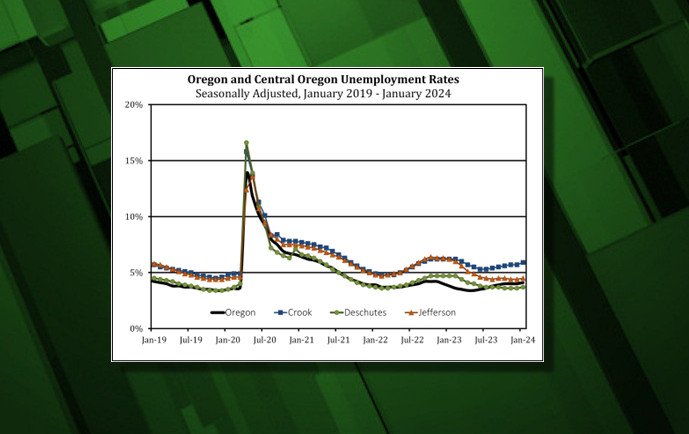Oregon loses nearly 5,000 jobs to start 2024; cold January trims Central Oregon workforce, but rates hold steady

SALEM, Ore. (KTVZ) -- In January, Oregon’s seasonally adjusted nonfarm payroll employment dropped by 4,900 jobs, following a revised gain of 1,900 jobs in December, the Oregon Employment Department reported Tuesday.
In a rare start-of-year occurrence, Central Oregon's jobless rates also were released Tuesday, and while the January winter weather contributed to a reduced workforce, unemployment rates held fairly steady.
January’s statewide job losses were largest in professional and business services (-1,700 jobs); leisure and hospitality (-1,600); other services (-1,400), transportation, warehousing, and utilities (-1,200); and construction (-600). Gains in January were largest in health care and social assistance (+1,100 jobs) and manufacturing (+500).
Over the most recent 12 months, jobs edged lower. Oregon’s seasonally adjusted nonfarm payroll employment dropped by 4,900 jobs, or -0.2%, between January 2023 and January 2024. The private sector cut 15,200 jobs, or -0.9%, over the most recent 12-month period.
Job losses in four major industries stood out, each down by between 3,700 and 9,500 jobs. These industries are information; professional and business services; manufacturing; and retail trade. Five other major industries had smaller losses, between 700 and 2,200 jobs. In contrast, health care and social assistance is up 13,400 jobs, or 4.8%, while government is up 10,300 jobs, or 3.4%, in the 12 months through January.
Annual revisions indicate less robust construction employment than originally estimated. Construction employed 116,700 in January, which was close to its headcount during each of the past 18 months. Professional and business services was also revised lower, showing that the industry contracted by 9,500 jobs, or -3.6%, in the most recent 12 months. Over-the-year job declines occurred in each of this major industry’s three components: administrative and waste services (-5,800 jobs); professional and technical services (-3,000); and management of companies and enterprises (-700).
While Oregon’s job growth has been close to flat in the 12 months ending in January, with a decline of 0.2%, at the national level U.S. jobs grew by 1.9% and rose in every month of that period.
Oregon’s unemployment rate was 4.1% in January and 4.0% in December. It has remained in a tight range between 3.4% and 4.2% for more than two years, back to October 2021. The U.S. unemployment rate was 3.7% in both December and January.
Next Press Releases
The Oregon Employment Department plans to release the statewide unemployment rate and employment survey data for February on Wednesday, March 20. County and metropolitan area unemployment rates for February will be released on Tuesday, March 26.
--
Employment in Central Oregon: January 2024
During a colder than normal January, employment losses across Central Oregon were higher than usual for this time of year, the Employment Department reported.
Annual benchmark revisions had minimal impact on the overall employment situation in 2023. The most significant change occurred in Jefferson County, where total nonfarm employment growth appeared to be flatter than initially estimated.
Crook County: The seasonally adjusted unemployment rate increased over the month of January and is now 5.9% — in January of last year, it was 6.2%. The unemployment rate remains 1.4 percentage points above the record low set before the pandemic, when it was 4.5%.
Crook County lost 110 jobs in January, with most losses occurring in professional and business services (-40 jobs) and information (-40 jobs). Employment levels in Crook County are now 7.2% above pre-pandemic levels in February 2020 (+480 jobs).
The county lost 370 jobs in the last year (-5.1%). Job losses were concentrated in construction (-140 jobs) and information (-140 jobs). Marginal gains were concentrated in private education and health services (+30 jobs), and trade, transportation, and utilities (+10 jobs).
Deschutes County (Bend-Redmond MSA): The seasonally adjusted unemployment rate increased to 3.7% in January from 3.6% in December. The unemployment rate in January remains 0.3 percentage point above its record low of 3.4%, set before the onset of the pandemic.
The Bureau of Labor Statistics estimates that Deschutes County lost 2,620 jobs (-2.7%) from December to January. Most losses were concentrated in trade, transportation, and utilities (-620 jobs), followed by leisure and hospitality (-590 jobs), and mining, logging, and construction (-430 jobs). Total nonfarm employment is now 92,730.
Total nonfarm employment expanded by 2.4% (+2,160 jobs) from January 2023. Year-over-year job gains were concentrated in leisure and hospitality (+1,200 jobs) and private education and health services (+960 jobs). Other notable job gains took place in trade, transportation, and utilities (+230 jobs); other services (+160 jobs); and manufacturing (+120 jobs). Over-the-year losses occurred in mining, logging, and construction (-340 jobs); information (-170 jobs); and government (-120 jobs)
Revised 2023 estimates using payroll tax records are also now available. Deschutes County revisions were modest, with total nonfarm employment being revised down by less than 1%.
Jefferson County: The seasonally adjusted unemployment rate increased slightly over the month of January and is now 4.5%. The unemployment rate was 4.4% from October 2019 to December 2019, shortly before the first impacts from COVID-19.
Total nonfarm employment decreased by 220 jobs in January (-3.3%). Job losses were concentrated in the public sector (-80 jobs), with most losses occurring in local tribal government (-90 jobs). Other notable losses occurred in manufacturing (-40 jobs); trade, transportation, and utilities (-30 jobs); and financial activities (-30 jobs). All other industries registered little to no change over the month. Total nonfarm seasonally adjusted employment is now -0.9% (-60 jobs) below the pre-pandemic employment level.
Jefferson County’s total nonfarm employment decreased by 10 over the past year (-0.2%). Recent benchmarking revisions revealed that the recovery was slower than initially estimated in 2023. Job losses were concentrated in manufacturing (-50 jobs), construction (-30 jobs), and retail trade (-30 jobs). Gains were concentrated in private education and health services (+40 jobs); professional and business services (+30 jobs); and government (+30 jobs).